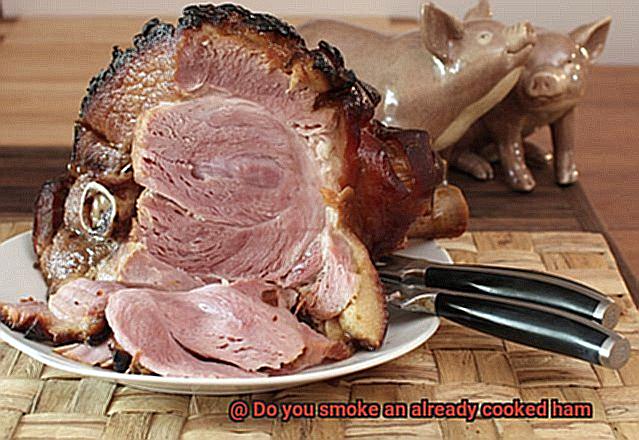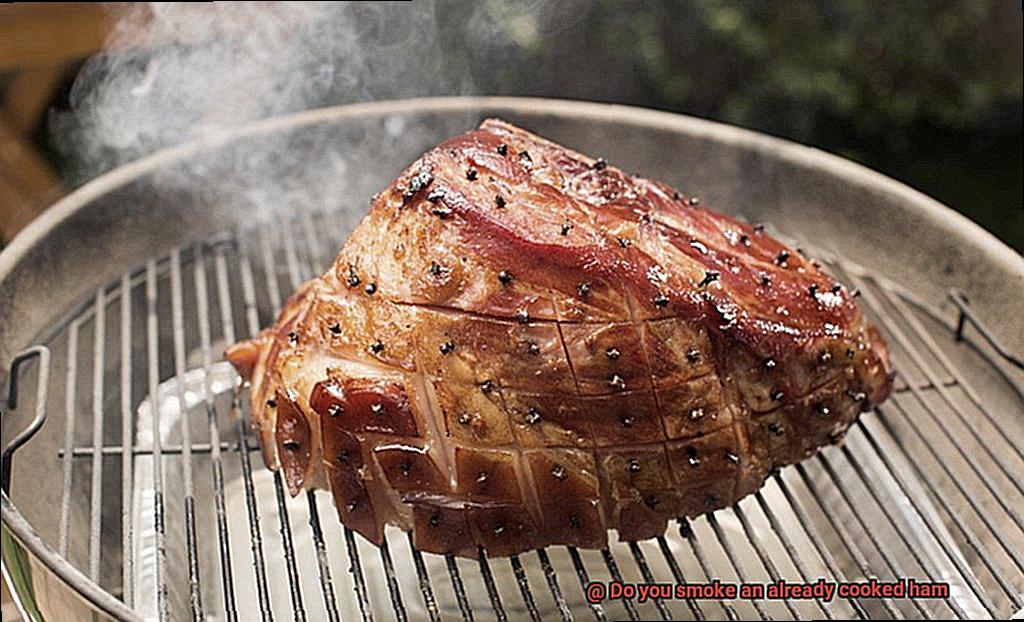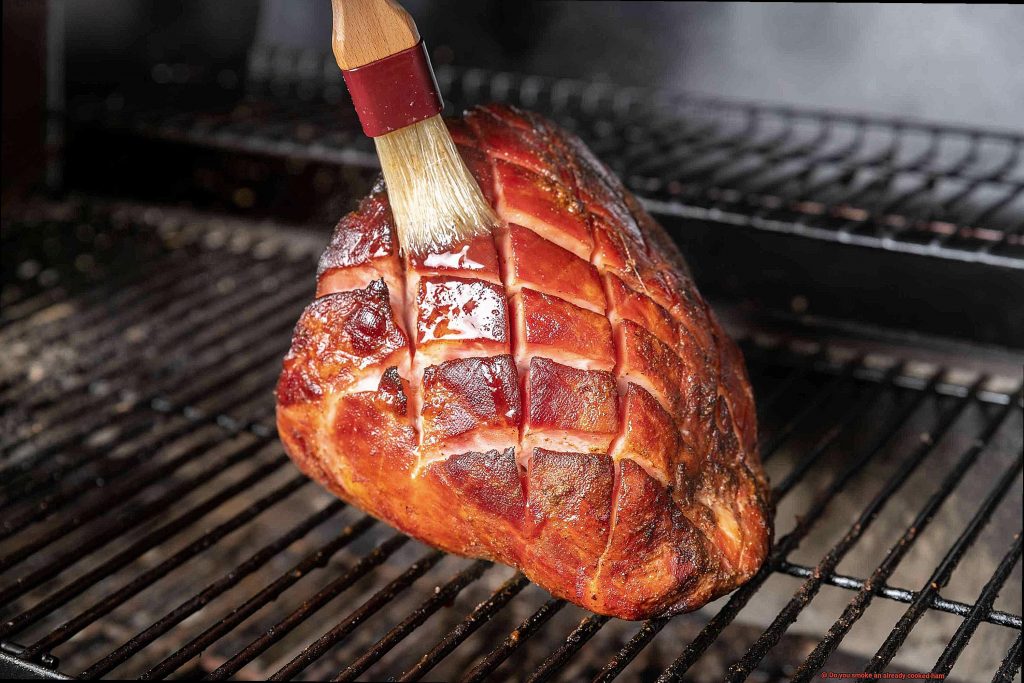Are you a ham aficionado looking to take your meal to the next level? Have you ever wondered whether smoking an already cooked ham is possible? Wonder no more. In this post, we’ll delve into the world of smoked ham and explore the possibilities.
Smoking meat has been around for centuries, and it’s not just for raw meats. Smoking an already cooked ham can add a unique and intense flavor that can’t be matched by any other method. It’s a great way to experiment with new flavors and textures and impress your guests with your culinary prowess.
But before you start smoking that ham, keep in mind that it’s a delicate process that requires some time and patience. We’ll guide you through the best method to smoke an already cooked ham step-by-step, including the tools you need to get started.
So, grab your apron and let’s get smoking. With our tips, you’ll be able to transform your already cooked ham into a succulent masterpiece bursting with smoky goodness.
Contents
What to Consider Before Smoking a Cooked Ham
Are you ready to elevate the flavor of your cooked ham with a smoky twist? Before you get started, it’s important to consider a few factors to ensure that your smoked ham is both safe and delectable.
- Ham Type: The type of ham you have will impact the outcome of your smoked ham. If your ham is already cured or smoked, it may not need additional smoking. However, if you have a fresh or unprocessed ham, smoking it can add a new depth of flavor to its taste.
- Wood Type: The type of wood chips or pellets you choose is also essential in creating the perfect smoky flavor. Hickory wood produces a robust and smoky flavor that pairs well with pork, while applewood chips create a sweeter, milder taste. Choose the wood based on your preference and what will complement the flavors in your ham.
- Time: Smoking a ham can take several hours, so it’s important to plan accordingly. Make sure you have enough time set aside for the entire process. Additionally, use a meat thermometer to monitor the temperature of your ham and ensure that it reaches an internal temperature of 140°F (60°C).
- Seasoning: Make sure your ham is properly thawed and seasoned before smoking. Allow the ham to thaw in the refrigerator for at least 24 hours before smoking it. Enhance its flavor by seasoning it with a dry rub or marinade.
- Size: The size of your ham will also factor into the smoking process. Make sure your smoker is large enough to accommodate the size of your ham.
In conclusion, smoking an already cooked ham can be a delicious addition to any meal.
Choosing the Right Type of Wood Chips for Smoking
Smoking an already cooked ham can take your meal to the next level, but the secret to achieving that perfect smoky flavor lies in choosing the right type of wood chips. As an expert in this field, I can tell you that different types of wood chips offer different flavors and aromas. So, it’s crucial to choose the right one that complements the taste of your ham.
Let’s dive into some popular types of wood chips that are ideal for smoking a ham:

- Applewood: With its mild and fruity flavor, applewood pairs perfectly with the sweetness of ham.
- Cherrywood: This wood has a subtle sweetness and touch of tartness that enhances the flavor of ham.
- Hickory: Known for its strong and bold taste, hickory can overpower the flavor of ham if used excessively.
- Mesquite: Another bold wood, mesquite imparts a smoky flavor with a hint of sweetness.
- Oak: A versatile wood that offers a subtle smoky flavor without overpowering the taste of ham.
When selecting wood chips, be sure to use high-quality chips that are free from chemicals and additives. Avoid using softwoods like pine or cedar as they can give off an unpleasant taste and aroma.
Consider the size of your smoker and how long you plan to smoke the ham when selecting the amount of wood chips required. Larger smokers may require more wood chips, while smaller ones may need less. For optimal results, soak your wood chips in water for at least 30 minutes before smoking to prevent them from burning too quickly.
The Smoking Process: Temperature and Time
Temperature and time are the critical factors that can either make or break your dish.
When it comes to temperature, you’ll want to smoke your ham between 225-250°F. This range allows the ham to cook slowly and absorb the smoky flavors. However, it’s essential to ensure that the internal temperature of the ham reaches at least 140°F to make it safe to eat. Always use a meat thermometer to monitor the temperature throughout the smoking process.
Time is another essential consideration when smoking an already cooked ham. Typically, it takes between 2-3 hours to achieve delicious results. Slow cooking allows for maximum flavor infusion and ensures that the ham remains juicy and tender.
The type of wood used for smoking is also crucial in adding flavor to your ham. Hickory is a popular option that imparts a bold and smoky flavor, while applewood adds a fruity and sweet note. Cherrywood is a great choice as it adds a subtle sweetness without overpowering the ham’s natural flavor.
For those seeking to take their smoked ham to another level, glazes and rubs can add an extra layer of flavor complexity. A simple glaze made with brown sugar, honey, and mustard can add a perfect balance of sweetness and tanginess.
Using a Meat Thermometer to Monitor Internal Temperature
In our last section, we talked about the art of smoking an already cooked ham. Today, let’s dive into the nitty-gritty of using a meat thermometer to monitor the internal temperature of your ham. No one wants to serve undercooked meat at their dinner party, and using a meat thermometer is the most accurate way to ensure that your ham is safe to eat.
There are several types of meat thermometers available, including digital, analog, and leave-in thermometers. Digital thermometers are the most popular because they provide quick and accurate readings. Analog thermometers are also reliable but take longer to read and require calibration from time to time. Leave-in thermometers are perfect for long cooking times, as they can stay in the meat while it cooks and be easily read through a digital display.
To use a meat thermometer, start by inserting the probe into the thickest part of the ham, making sure not to touch any bone. The thermometer should be inserted at least 1 inch into the meat for an accurate reading. Once you’ve inserted the thermometer probe, wait a few seconds for the temperature to stabilize before reading it. This will give you an accurate reading of the internal temperature of your ham.
The USDA recommends heating smoked hams to an internal temperature of 140°F. However, if you prefer your ham to be warmer or hotter, you can continue cooking it until it reaches your desired temperature. Just make sure to keep checking the internal temperature with the meat thermometer until it reaches your desired level of doneness.
But wait, there’s more. Proper storage is essential after cooking your smoked ham. Smoked hams can be stored in the refrigerator for up to one week or frozen for up to six months. When reheating a smoked ham, make sure to use a meat thermometer again to ensure that it reaches an internal temperature of 165°F before serving.
Benefits of Smoking an Already Cooked Ham
As an expert on the benefits of smoking, I’m here to tell you that this method can take your ham from basic to extraordinary in just a few simple steps.
First and foremost, smoking your ham can enhance its flavor and texture. The smoke infuses into the meat, creating a rich and savory taste that is simply delicious. Smoking also helps to tenderize the ham, making it more succulent and juicy. Who doesn’t love the taste of smoky, mouth-watering ham?
But that’s not all – smoking an already cooked ham can also add variety to your meals. You can experiment with different types of wood chips and seasonings to create unique flavors and aromas. Applewood, hickory, and mesquite are just a few examples of the many options available to you. The possibilities are endless.
Another benefit of smoking an already cooked ham is that it can help preserve the meat. Smoking acts as a natural preservative, extending the shelf life of the ham. This is especially helpful if you have leftovers that you want to enjoy for several days after your initial meal.
Finally, smoking an already cooked ham is a relatively easy process that requires minimal effort on your part. All you need is a smoker, some wood chips, and your already cooked ham. Simply add the wood chips to the smoker, place the ham inside, and let it smoke for several hours until it reaches your desired level of smokiness. It’s that easy.
Potential Risks of Smoking an Already Cooked Ham
If you’re thinking of smoking an already cooked ham, it’s important to know that there are potential risks involved. As an expert on this topic, I’ve done some research and found some crucial aspects to keep in mind to ensure a safe and delicious meal.
First and foremost, the biggest risk is the possibility of foodborne illness. Bacteria can grow and multiply quickly when meat is left at room temperature for too long, which can lead to serious illnesses such as salmonella or E. coli if consumed. To avoid this, always keep your ham refrigerated until you’re ready to smoke it. Additionally, use a meat thermometer to monitor the temperature of the ham while smoking and make sure it reaches a safe internal temperature of 145°F.
Another risk to consider is overcooking and drying out the meat. This can result in a tough, chewy texture and a lack of flavor. To prevent this, keep a close eye on the temperature of the ham while smoking and don’t let it cook for too long. A meat thermometer can help you monitor the temperature and ensure it doesn’t get too high.
In addition to these risks, there’s also a chance that the smoke flavor could overpower the natural flavors of the ham. While smoking can add a delicious smoky taste to meats, it’s important not to go overboard and mask the natural flavors of the ham. To achieve a balanced flavor, consider using mild wood chips like apple or cherry instead of stronger woods like hickory or mesquite.
Furthermore, there’s a risk of burning the ham if proper precautions aren’t taken. Use indirect heat when smoking and keep a close eye on the ham at all times. Wrapping the ham in foil or using a drip pan can also help prevent any flare-ups.

Tips for Smoked Hams
Smoking an already cooked ham can take it to a whole new level of flavor and make it a perfect centerpiece for any holiday meal. However, it can also be a little tricky to get the perfect balance of smokiness without drying out the ham. Here are some tips to help you smoke your ham like a pro:
Choose the right type of wood
The type of wood you use can make a big difference in the flavor of your smoked ham. Hickory, applewood, and cherrywood are all great options that pair well with ham. Hickory has a strong and bold flavor, while applewood adds sweetness, and cherrywood gives a fruity aroma.
Use a glaze
A sweet glaze can help balance out the smoky flavor and keep the ham from drying out. A mixture of honey, brown sugar, and mustard is a classic choice. You can also experiment with different flavors like maple syrup or apricot preserves.
Keep an eye on the temperature
Since the ham is already cooked, you don’t need to worry about cooking it to a specific temperature. However, you do want to make sure that the internal temperature doesn’t get too high or it will dry out. Aim for a temperature between 140-150°F. Use a meat thermometer to monitor the temperature.
Wrap it up
After smoking, wrap your ham in foil and let it rest for at least 30 minutes before slicing. This will help keep the juices in and ensure a moist and flavorful ham. You can also add some liquid like chicken broth or apple juice to the foil to keep the ham moist.
Take your time
Smoking a ham is not a quick process, but it’s worth it for the delicious flavor it adds. To achieve the best results, smoke the ham low and slow for several hours. This means cooking it at a low temperature (around 225-250 degrees Fahrenheit) for several hours until it reaches an internal temperature of at least 140 degrees Fahrenheit.
This slow cooking process allows the smoke to infuse into the meat while also keeping it tender and juicy.
How to Rest the Smoked Ham
Resting a smoked ham is an essential step in ensuring that the meat is juicy and tender. Don’t rush the process and give yourself enough time to rest the ham properly. Here are some tips and tricks to help you rest your smoked ham to perfection.
Choose the Right Time
When smoking a ham, timing is everything. Allow yourself enough time to rest the ham properly. Plan ahead and give yourself at least 30 minutes for smaller hams and up to an hour for larger ones. This will ensure that the meat is not hot, making it easier to carve.
Wrap it Up
Once your ham is cooked, immediately remove it from the smoker or grill and wrap it tightly in aluminum foil. This will help keep it warm and prevent any moisture from escaping. Be sure to wrap it tightly so that no air can get in, allowing the juices to redistribute evenly.
Let it Rest
Be patient and let your ham rest for at least 30 minutes before carving into it. During this time, the juices will redistribute throughout the meat, making it more tender and flavorful. Avoid poking or cutting into the ham during this time as this will release all the juices, resulting in a dry and tough meat.
Check the Temperature
Before serving your smoked ham, check the internal temperature using a meat thermometer. The recommended temperature for fully cooked ham is 145°F. Make sure you check the thickest part of the ham to ensure that it has reached the appropriate temperature. This ensures safe consumption while also preserving the juicy texture of the meat.
Carve with Care
When it’s finally time to carve your smoked ham, be gentle. Use a sharp knife and slice across the grain of the meat for maximum tenderness. Avoid slicing too quickly or aggressively as this can cause the juices to escape, leaving you with a dry and tough meat.
-6a43-Z2WFM” >
Conclusion
In conclusion, smoking an already cooked ham is a surefire way to elevate your meal’s flavor profile. By employing the right tools and techniques, you can transform your ham into a succulent masterpiece bursting with smoky goodness. However, it’s important to consider several factors before lighting up your smoker, such as the type of wood chips or pellets you use, the time it takes to smoke a ham, and the seasoning you apply beforehand.
Selecting the appropriate wood chips is crucial in creating that perfect smoky flavor. Applewood, cherrywood, hickory, mesquite, and oak are all excellent options that offer unique flavors and aromas. Additionally, monitoring the temperature of your ham using a meat thermometer is essential to ensure it reaches an internal temperature of 140°F (60°C) for safe consumption.
While there are potential risks involved in smoking an already cooked ham – such as foodborne illness or overcooking and drying out the meat – following these tips can help mitigate those risks. Taking your time and resting your smoked ham properly after cooking it low and slow for several hours will yield delicious results that will impress even the most discerning palate.
So why not try smoking an already cooked ham at your next gathering? With these tips in mind, you’ll be well on your way to creating a mouth-watering dish that will leave everyone clamoring for seconds. Don’t be afraid to experiment with different wood chips or seasonings until you find the perfect combination that suits your taste buds.






